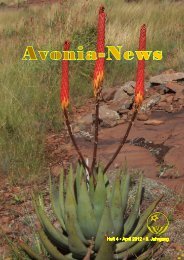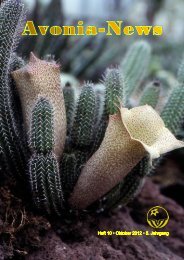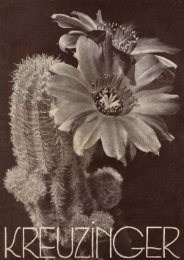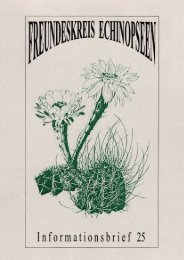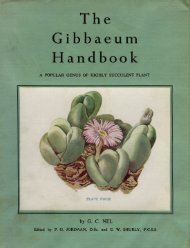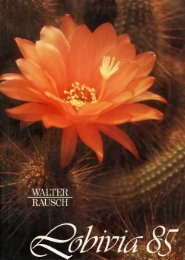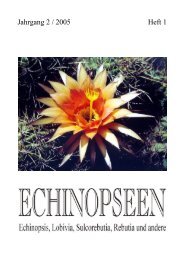VOLUME 14 :: January—October, 1952 Illustrations shown in ...
VOLUME 14 :: January—October, 1952 Illustrations shown in ...
VOLUME 14 :: January—October, 1952 Illustrations shown in ...
You also want an ePaper? Increase the reach of your titles
YUMPU automatically turns print PDFs into web optimized ePapers that Google loves.
22 THE CACTUS AND SUCCULENT January, <strong>1952</strong><br />
REPORTS OF MEETINGS<br />
November 6th, 1951 : Mr. A. Boarder—How to avoid flower failures<br />
I do not pretend to know all the answers, but only my own observations over many years and if you get results<br />
you must be on the right track. People make statements <strong>in</strong> pr<strong>in</strong>t and, thereafter, everyone who writes on the<br />
subject repeats them. For <strong>in</strong>stance, that our plants will flower only when pot-bound. Very few of my plants<br />
are pot-bound and they flower freely. My plant of Mammillaria bocasana had one hundred and fifty flowers at one<br />
time dur<strong>in</strong>g this summer. Another th<strong>in</strong>g that is wrong, is that if they have a good roast<strong>in</strong>g <strong>in</strong> sunsh<strong>in</strong>e one year,<br />
they will flower better the follow<strong>in</strong>g year. This year's seedl<strong>in</strong>g of Mammillaria rettigiana is budd<strong>in</strong>g for flower<br />
and that's not from what it has received the previous year.<br />
Mammillaria rhodantha is late flower<strong>in</strong>g on this year's growth. If no new growth, no flower buds <strong>in</strong> the centre.<br />
My Mammillaria sp<strong>in</strong>osissima has two r<strong>in</strong>gs of dried seed pods. The higher ones are from this year's flowers. Some<br />
will not flower on old wood, but on the current year's growth and others on the growth of the previous year.<br />
This little plant (Mr. Boarder displayed it) has flowered and produced a seed pod. It is probably self fertile. It<br />
has hooked sp<strong>in</strong>es. It will be <strong>in</strong>terest<strong>in</strong>g to see what happens. Some Mams, flower between every tubercle.<br />
Astrophytums flower at every areole, but only on new growth. Notocactus flower <strong>in</strong> a r<strong>in</strong>g on new growth. Lobivias<br />
flower on last year's wood. Rebutias flower low down and <strong>in</strong> the follow<strong>in</strong>g year on newer wood. The best flowers<br />
of Stapelias are on new growth. Epiphyllums will flower on last year's growth ; naturally, they grow <strong>in</strong> steamy,<br />
clammy conditions. Mammillaria woodsii flowers on this year's growth. Ech<strong>in</strong>opsis will flower <strong>in</strong> a room with a<br />
small amount of sunsh<strong>in</strong>e, but with more sunsh<strong>in</strong>e there will be more flowers. Better growth—better flowers,<br />
therefore, keep them grow<strong>in</strong>g.<br />
There is an old say<strong>in</strong>g that they should have a long w<strong>in</strong>ter's rest and that they should be exposed to scorch<strong>in</strong>g<br />
sun, but I do not f<strong>in</strong>d these maxims confirmed. Sun does make a difference I agree ; Lithops buds may show colour<br />
and the sun will br<strong>in</strong>g the flowers out. Pleiospilos and Lithops will hang fire wait<strong>in</strong>g for the sun. I give no shade to<br />
my plants except for the first six months of their life. My greenhouse is open all through the summer weather.<br />
Dur<strong>in</strong>g the w<strong>in</strong>ter's rest I cannot quite see why I should not occasionally give my plants a careful water<strong>in</strong>g<br />
as if they are dry too long, the t<strong>in</strong>y fibrous roots die.<br />
It is ridiculous to keep a plant <strong>in</strong> a pot for three years or more, as a lot of dead roots accumulate and get packed<br />
tight and root bug comes, sucks and damages the root and the plant dies. Some will not want larger pots, but will<br />
appreciate fresh soil. When re-pott<strong>in</strong>g, renew with fresh soil. If pott<strong>in</strong>g-on <strong>in</strong> August when the pot is outgrown,<br />
just lift out carefully and place <strong>in</strong> a larger pot, gently plac<strong>in</strong>g fresh soil around it—it will make better growth.<br />
We cannot imitate the conditions <strong>in</strong> which the plants are found, so it is a wonder we flower as many as we do<br />
when one considers the vast distances apart where they grow, represent<strong>in</strong>g many differences <strong>in</strong> temperature<br />
and condition ; we assemble and flower them <strong>in</strong> one small greenhouse.<br />
If you want to try old cow manure—all right, but it is one th<strong>in</strong>g to use it <strong>in</strong> open ground, but entirely another<br />
to use it <strong>in</strong> a small pot. With spent mushroom compost, quite a lot of the fire and goodness has gone from it, but<br />
it is good clean stuff, although it may clog. It is good for mix<strong>in</strong>g with the soil for Epiphyllums, but be on your guard<br />
for fungus.<br />
I have been told I blow my plants up with a pump, so now I blow flowers on them. However, I am satisfied.<br />
There are one hundred and twenty-four genera of cacti with many of which I have been successful. Cereus have<br />
flowered <strong>in</strong> four years from seed. Other succulents will flower the same year from seed, if they have someth<strong>in</strong>g<br />
good to grow <strong>in</strong>, such as, two parts loam, one part peat, one part sharp sand ; add |- 02. limestone, £ oz. sulphate<br />
of potash, li oz. hoof and horn grist and l| oz. superphosphate per bushel and you can add someth<strong>in</strong>g rough like<br />
broken brick, with a little charcoal for mature plants. Hoof and horn grist is a good long and short term fertiliser.<br />
When I say loam, I mean loam with grass stacked down ; do not throw the grass away when break<strong>in</strong>g up loam<br />
from Ketter<strong>in</strong>g.




